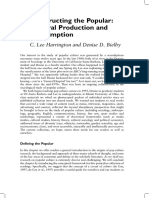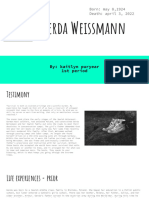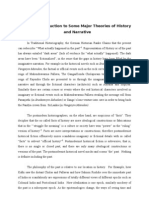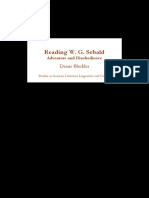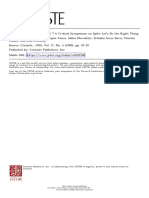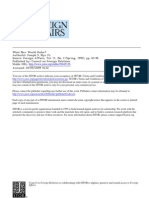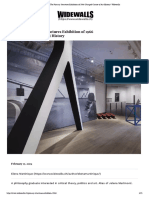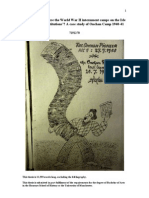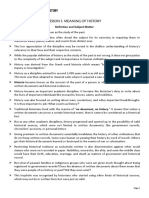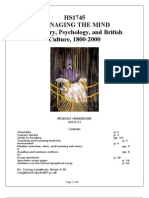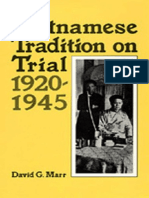Biography As History
Biography As History
Uploaded by
csinglerCopyright:
Available Formats
Biography As History
Biography As History
Uploaded by
csinglerOriginal Title
Copyright
Available Formats
Share this document
Did you find this document useful?
Is this content inappropriate?
Copyright:
Available Formats
Biography As History
Biography As History
Uploaded by
csinglerCopyright:
Available Formats
AHR Roundtable Biography as History
LOIS W. BANNER
I FIRST ENCOUNTERED BIOGRAPHY as a genre of history in the 1960s, when I was a Ph.D. candidate in the Columbia University history department specializing in U.S. politics during the early republic. Intrigued by Thomas Jefferson, I wrote a paper on the already large number of Jefferson biographies, which even then constituted a complex biographical tradition about him. By the early 1970s, inspired by the emerging feminist movement, I joined those historians who, similarly motivated, were creating the modern eld of womens history. From the beginning of our endeavor, we stressed the importance of uncovering the life stories of women forebears to serve as role models to dene ourselves and our careers in a male-dominated, masculinized profession. In 1967, Gerda Lerner pioneered the study of womens history in U.S. history with a dual biography of Sarah and Angelina Grimke , sisters who rejected the slavery of their childhood in Charleston, South Carolina, to relocate in Philadelphia, where they became leaders in the antebellum anti-slavery movement. Kathryn Kish Sklar began her distinguished career with a biography of nineteenth-century educator Catherine Beecher, following it with a study of Progressive reformer Florence Kelley. In 1979, I wrote a biography of Elizabeth Cady Stanton for the Little, Brown Library of American Biography.1 By the 1980s, the study of gender appeared, expanding womens history to include men and sexual minorities. In a pathbreaking 1986 article on gender in the American Historical Review, Joan Scott identied the analysis of subjective identity and its relationship to social organizations and cultural representations as a central way to proceed in understanding gender, with biography an effective tool. In her 2006 History Matters: Patriarchy and the Challenge of Feminism, medievalist Judith Bennett pointed out that several shifts toward biography had occurred among historians of women, inspired by Natalie Zemon Daviss The Return of Martin Guerre (1983) and Women on the Margins (1995). (In a recent AHR Forum on Scotts 1986 article on gender, Scott noted that Davis had inuenced her to take up the subject.) In a 2004
1 Gerda Lerner, The Grimke Sisters from South Carolina: Rebels against Slavery (New York, 1967), revised and expanded as The Grimke Sisters from South Carolina: Pioneers for Womans Rights and Abolition (Chapel Hill, N.C., 2004); Kathryn Kish Sklar, Catharine Beecher: A Study in American Domesticity (New Haven, Conn., 1973); Sklar, Florence Kelley and the Nations Work: The Rise of Womens Political Culture, 18301900 (New Haven, Conn., 1995); Lois W. Banner, Elizabeth Cady Stanton: A Radical for Womans Rights (Boston, 1980).
579
580
Lois W. Banner
survey of books, articles, and dissertations in womens history, Lerner concluded that about one-fourth had adopted a biographical approach.2 Historians in general, however, often rank biography as an inferior type of history. They see it as inherently limited because it involves only one life, derives from a belles-lettres tradition rather than a scientic or sociological one, and is often written by non-academic historians who attract a lot of readers but lack the rigor of Ph.D.-trained scholars. Scholarly developments over the course of the twentieth century have also contributed to the dening of biography as second-rate. Such a downgrading was implicit in the approach of the new critics in literary studies in the 1930s, who called for analyzing texts apart from the lives of their authors; in the new social historians of the 1960s, who focused on demography, statistics, and groups; and in the deconstructionists of the 1970s, who wrote about the death of the author and saw texts as independent entities.3 Having written social and cultural history as well as biography, I propose that there are many similarities between these genres. At its best, biography, like history, is based on archival research, interweaves historical categories and methodologies, reects current political and theoretical concerns, and raises complex issues of truth and proof. It challenges the analyst to move beyond easy platitudes to engage in what Clifford Geertz famously called thick description.4 Moreover, given the long tradition among biographers of writing accessible prose, biography challenges the historian to produce lucid writingnot always the standard among academic scholars. No sophisticated biographer any longer reduces a life to a few categories or merely chronicles day-to-day experience, glossing over historical, literary, and geographical contexts. Psychohistorical interpretations remain valuable, especially in view of the fact that the biographical use of psychohistory has become much more sophisticated since its introduction in the 1920s in the form of a crude Freudianism dominated by the Oedipus complex or the search for a primal event that determined a life trajectory. The theories of neo-Freudians, Eriksonians, Kleinians, and others have been effectively used to understand lives, as in the biographies written by Fawn Brodie, especially her biography of Thomas Jefferson. In that work she employs a number of insights from Freud and Erikson to inform her narrative without overwhelming it.5 What is now called the new biography rst appeared in the 1990s. Its practitioners have been especially inuenced by feminist, postmodern, and race theorists.
2 Joan W. Scott, Gender: A Useful Category of Historical Analysis, American Historical Review 91, no. 5 (December 1986): 10531075; Judith Bennett, History Matters: Patriarchy and the Challenge of Feminism (Philadelphia, 2006), 24; Natalie Zemon Davis, The Return of Martin Guerre (Cambridge, Mass., 1983); Davis, Women on the Margins: Three Seventeenth-Century Lives (Cambridge, Mass., 1995); Gerda Lerner, U.S. Womens History: Past, Present, and Future, Journal of Womens History 16, no. 4 (2004): 1027; Joan W. Scott, Unanswered Questions, American Historical Review 113, no. 5 (December 2008): 1422. 3 See Steve Weinberg, Biography: The Bastard Child of Academe, Chronicle of Higher Education 54 (May 9, 2008): 15. 4 Clifford Geertz, Thick Description: Toward an Interpretive Theory of Culture, in Geertz, The Interpretation of Cultures: Selected Essays (New York, 1973), 330. 5 Laura Marcus, The Newness of the New Biography: Biographical Theory and Practice in the Early Twentieth Century, in Peter France and William St. Clair, eds., Mapping Lives: The Uses of Biography (New York, 2002), 193218; Fawn M. Brodie, Thomas Jefferson: An Intimate Biography (New York, 1974).
AMERICAN HISTORICAL REVIEW
JUNE 2009
Biography as History
581
Feminists and postmodernists focus on the diversity and complexity of movements and institutions and decry what they call essentialism, while theorists of race challenge the belief that women and men are unied categories of identity that do not vary by race. Biographers practicing the new biography stress the shifting and multifaceted nature of individual personality. In an impressive essay on the new biography, Jo Burr Margadant argues that there is no such thing as a coherent self, no unied I. The only selves that exist, according to Margadant, are those that individuals perform to create an impression of coherence.6 I appreciate Margadants position, but I do not entirely agree with her. For her stance implies a denial of the probability that elements of personality developed in childhood can remain coherent over a lifetime, or that the social and cultural modalities that inuence personality development can encourage the production of a xed core within an individual persona. Even today, many psychologists, whatever their theoretical training, probe a clients memories of childhood in order to access basic elements of personality. Life-cycle theorists, who trace their approach to Renaissance precedents, as in the famed ages of man speech in Shakespeares As You Like It, posit the existence of life stages determined both by the aging process and by cultural denitions of those stages through which each individual passeswith predictable crises along the way. According to these theorists, human personalities are periodically rearranged in line with cultural imperatives, internal biology (uctuating hormonal production, for example), and cumulative life experiencewhat we sometimes call wisdom. Conversely, some life-cycle analysts conclude that by their thirties, most individuals are incapable of much personality change.7 In Orlando, Virginia Woolfs spoof of the genre of biography based loosely on the persona of her friend Vita Sackville-West, Woolf tracked her central character through centuries of gender-crossing from male to female and back again. In that text Woolf, who often commented on biography, wrote that a biography is considered complete if it merely accounts for six or seven lives, whereas a person may well have as many as a thousand.8 Woolfs statement anticipates the deconstructive stance of todays new biographers in dening identity as multifaceted. But the satire implicit in her remarks implies the opposite: no matter the fault lines in individual personality, xity may exist at the core of identity as well as in the culture that surrounds it, as in the Victorianism, modernism, and patriarchy that Woolf identied in other writings as inuencing her own construction of self. We are not just a Babel of voices. Nor is the culture that surrounds us. In line with its emphasis on the self as variegated, the new biography also emphasizes the power of culture in shaping the self, in accord with the belief that culture, not nature, is the primary force molding individual personality. That position has been a central tenet of feminist theory since it emerged in the 1970s, and the argument has been reinforced more recently by theorists of performativity.9 These
6 Jo Burr Margadant, ed., The New Biography: Performing Femininity in Nineteenth-Century France (Berkeley, Calif., 2000), 7. 7 See my In Full Flower: Aging Women, Power, and Sexuality (New York, 1992). 8 Virginia Woolf, Orlando (1928; repr., New York, 1956), 309. 9 The classic text on performativity is Judith Butler, Gender Trouble: Feminism and the Subversion of Identity (New York, 1990).
AMERICAN HISTORICAL REVIEW
JUNE 2009
582
Lois W. Banner
theorists view human personality in general and gender character in particular as roles that individuals playroles scripted primarily by the surrounding culture. Individuals internalize these roles, on the one hand, and rebel against them, on the other, both policing and individuating themselves according to cultural conventions. The reverse is also the case. If we regard the individual as the text and the surrounding culture as the context, it follows that the individual text not only reects the context but also inuences it, in a reciprocal interaction that, following Mikhail Bakhtin, I call dialogic. From Napoleon creating an empire to Eleanor Roosevelt successfully lobbying for blacks and women during the New Deal, individuals inuence historical development. And from this perspective, studying the life story of an individual might be seen as akin to studying the history of a city, a region, or a state as a way of understanding broad social and cultural phenomena. As Margadant writes, cultural politics are most easily examined as well as empathetically imagined in the individual life.10 Empathetically imagined: that phrase in Margadants statement speaks to the human desire for interconnection with others as well as to biographys appeal in charting analogies and inspirations by which its readers can understand and construct their own lives. Such impulseswhich are ethical and personal in dimensionhave remained key elements of biography ever since the forms halcyon days in the nineteenth century, when it was often considered to be an ethical endeavor focused on surveying the heroic lives of eminent men in order to uplift and inspire its readers. No less than historians in general, biographers are detectives and interpreters, attempting to illuminate the past and to interweave its threads in new and compelling patterns. A life deeply lived, like any complex historical narrative, moves across space, time, and areas of human involvement both capriciously and predictably, validating certain accepted historical constructions while challenging others. Understanding a life may require that a biographer retrain in new kinds of historical investigation, such as oral historyto interview friends, relatives, and associates of the biographical subjector psychohistoryto probe underlying motivations. The historian writing a biography may have to move beyond his or her geographic period or eld of specialization to engage decades of development and new elds of knowledge. A life span of seventy years, after all, encompasses nearly a century of historical development. Biography raises issues of ancestry, kinship, family, and friendship. It invariably involves the history of sexuality; it may involve the histories of ethnicity, class, race, medicine, religion, education, workforce participation, and even architecture and interior design. Biography is also related to matters of dress and appearance: how a person looked, including such things as clothing and cosmetics, may be as important to understanding that person as any other variable in his or her life. How do we explore the history of race in the twentieth century without consulting the life story of Josephine Baker, who dominated the Parisian stage in the 1920s and inuenced the look of women across two continents? In her brilliant biography of Marie Antoinette, Caroline Weber demonstrates the importance to the origins of the French Revolution of the clothing that Marie Antoinette wore, while in an important bio10 M. M. Bakhtin, The Dialogic Imagination: Four Essays (Austin, Tex., 1988); Margadant, The New Biography, 7.
AMERICAN HISTORICAL REVIEW
JUNE 2009
Biography as History
583
graphical essay, Mary Sheriff explores the French queens relationship to the geography of Versailles and to the paintings done of her.11 No less than other types of history, biography raises issues of revisionism and historiography key to the historical enterprise. Important individuals, like important events, can spawn multiple and diverse studies, as in the never-ending stream of biographies of the founding fathers of the United States and of Abraham Lincoln. The lives of these men have become sounding boards for what the nation thinks of itself. More recently, the life of ur-imperialist Theodore Roosevelt has become paradigmatic for students of the imperial presidency looking for historical roots for their subject. And distinguished biographies sometimes provide the most insightful histories of events and experiences, as does Elinor Accampos biography of Nelly Roussel on maternity and femaleness in Third Republic France, or biographies of U.S. civil rights leaders on the broad dimensions of that movement.12 Moreover, biographical narratives may intersect with new historical elds. Students of colonialism and of population movements are demonstrating that throughout history, individualswhether well-known or unknownjourneyed across continents and oceans in pursuit of adventure or economic opportunity, or because they were following husbands and families, or because they were forced to do so after having been sold into slavery. Biographers tracking the lives of such individuals may have to become transnational historians, themselves crossing oceans in pursuit of records about their subjects, and even learning new languages to be able to read their sources. Actors and entertainers have often been peripatetic, journeying worldwide on theater tours. International elites created transnational networks, including cafe society in the 1920s and the jet set in the 1950s. These transnational individuals challenge the notion of nation itself, opening up the eld of history to the possibility of new frameworks.13 And biography may be collective, involving a comparison of several lives or an analysis of a number of lives together, linked through a central theme. I still read Lytton Stracheys 1922 Eminent Victorians and Richard Hofstadters 1958 The American Political Tradition for the felicity of these authors prose and their insights into writing history through collective biography. What better way to understand Victorian marriage than to read Phyllis Roses Parallel Lives? In that book Rose analyzed the lives of a number of famed English married couples in the nineteenth century to show how those marriages functioned.14 I followed the comparative approach in my biographical study of Ruth Benedict and Margaret Mead, whose lives as friends, lovers, and professional collaborators
11 Caroline Weber, What Marie Antoinette Wore to the French Revolution (New York, 2006); Mary D. Sheriff, The Portrait of the Queen, in Dena Goodman, ed., Marie Antoinette: Writings on the Body of a Queen (New York, 2003), 4571. 12 Elinor Accampo, Blessed Motherhood, Bitter Fruit: Nelly Roussel and the Politics of Female Pain in Third Republic France (Baltimore, 2006); John DEmilio, Lost Prophet: The Life and Times of Bayard Rustin (New York, 2003); Barbara Ransby, Ella Baker and the Black Freedom Movement: A Radical Democratic Vision (Chapel Hill, N.C., 2003). 13 On the importance of biography to transnational history, see, for example, David Lambert and Alan Lester, eds., Colonial Lives across the British Empire: Imperial Careering in the Long Nineteenth Century (Cambridge, 2006). 14 Lytton Strachey, Eminent Victorians (1922; repr., New York, 2002); Richard Hofstadter, The American Political Tradition and the Men Who Made It (1958; repr., Cambridge, Mass., 1996); Phyllis Rose, Parallel Lives: Five Victorian Marriages (New York, 1983).
AMERICAN HISTORICAL REVIEW
JUNE 2009
584
Lois W. Banner
were deeply intertwined. In order to write a thick study of their lives, I had to delve into intellectual history, the history of the professions, and the history of the concepts of race and racism. To write about Benedicts upbringing, I had to learn about the history of the Baptist Church. To write about Meads religious beliefs, I had to learn about the Episcopal Church. To understand their anthropological eldwork, I had to study the Pueblo Indians and the tribal indigenous people in Samoa and New Guinea. To elucidate Mead and Benedicts individual selves, sexually different from the norm, I had to investigate the history of lesbianism and bisexuality and to master queer theory. Then I had to read and analyze the 50,000 letters, documents, and other written materials about their lives in the Margaret Mead Papers at the Library of Congress, and gure out how to intertwine the story of their individual lives with the times in which they lived. Given the biographical subjects that I have chosenElizabeth Cady Stanton, Margaret Mead, and Ruth Benedictit is clear that I like to write about women who were prominent in their own day, although I did write a memoir of my high school best friend who converted to Islam.15 In my preference for prominent women, I go against the grain of recent theory in biography that calls for a focus on ordinary people. While I respect this imperative, I am drawn to assessing cultural leaders and icons who articulated cultural understandings rather than individuals who followed or contested them. This interest has led me to my current biographical project on Marilyn Monroe. For the past four years, I have immersed myself in the scores of biographies, memoirs, and novels about Marilyn, many of them lled with half-truths and outright lies. I have become a leader of the Marilyn Monroe Fan Club in Los Angeles, scoured archives throughout the nation, and interviewed a host of her friends and associates who are still alive. In her 2005 study of the biographies of Monroe, Sarah Churchwell skewered all of their authors for ungrounded speculation, poor footnoting, and treating as fact what was speculation in preceding biographies.16 But Churchwell, who did neither primary research nor oral interviews, didnt uncover the half of it. In my journey to understand Monroe, I have found prevarication at every turn. Many individuals fabricated relationships with her that never occurred and invented situations in her life that never happened. The story of my research to uncover one of these hoaxes was featured in the October 2008 cover story on Monroe in Vanity Fair. My critique of that article was published in the form of a letter to the editor in the magazines December issue. The matters of identity I have been charting are front and center in the case of Monroe. For Norma Jeane Baker, Marilyns original self, developed many characters in her quest to create the adult Marilyn Monroe, and she played them to perfection, both on screen and off. To some of her friends she seemed a gentle child, without much sex appeal, while to others she was the consummate vamp. She exchanged poetry with poet Norman Rosten and discussed novels, psychiatry, and mystical religions with Ralph Roberts, an actor-turned-masseur who was her condant during
15 Banner, Elizabeth Cady Stanton; Lois W. Banner, Intertwined Lives: Margaret Mead, Ruth Benedict, and Their Circle (New York, 2003); Banner, Finding Fran: History and Memory in the Lives of Two Women (New York, 1998). 16 Sarah Churchwell, The Many Lives of Marilyn Monroe (New York, 2004).
AMERICAN HISTORICAL REVIEW
JUNE 2009
Biography as History
585
the last two years of her life. For Arthur Miller, she was the consummate earth mother before he came to regard her as a drug-addicted demon. For Fred Vanderbilt Field, she was a left-wing radical who supported Fidel Castro. For Louella Parsons, she was a dignied woman who didnt stray from the path of virtue.17 Wearing disguises and constructing fabulist stories for reporters and columnists, she concealed much of her private life from the public. An ingenious trickster, Norma Jeane Baker created in Marilyn Monroe an epic masquerade as a dumb blonde, whose wiggling walk, jiggling breasts, childlike voice, and pouty lips dened a major version of femininity for the 1950s at the same time that she satirized it. Yet unlike other comedic blondes of the twentieth centuryMarie Wilson, for examplethere were always a number of Marilyns, some of whom didnt display the mannerisms. In line with the approach to biography that all the contributors to this roundtable have taken, I am interested in how Marilyns biography interacts with the history of her era. To understand her, I have had to become expert in the history of Hollywood, photography, celebrity, glamour, fandom, and iconography. I have also had to learn about the treatment of mental illness in the twentieth century, since her mother, her maternal grandmother, and her maternal grandfather were all institutionalized for mental disorders. I am constructing my biography as much topically as chronologically, alternately deconstructing Marilyn and the era in which she lived to elucidate the dialogic connections between them. And I am exploring various theoretical approaches to understanding gender, especially that of mens studies scholars who argue that masculinity was under serious threat in the 1950s. For in the nal analysis, the truth about Marilyn may lie in the history of men, not of women.18 My work in biography has expanded my horizons as a scholar, and it has also enhanced my teaching. It has enabled me to present large bodies of new literature to my students organized around central themes rooted in biography, expanding their knowledge base as well as my own, and fascinating them to no end through speculating on the glamour and ironies of past lives. Moreover, in a present-day world fraught with peril, my students are looking for role models after whom to pattern their own lives. They are searching for a critique of the contemporary culture based on consumption and the cult of celebrity, in which they often feel trapped, and for ways to understand the lives of celebrities and stars with whom they identify without knowing why. Reading biographies enables them to generate such critiques and such understandings. And empathizing with others through biography quickens for my students the process of transference that is a key to successful learning. By transference I mean that, as in the therapeutic situation, students emotionally identify with the texts they are reading and with the professors teaching them, thus engaging in a personally transformative process as they reect, through biography, on their own lives and
17 Lois W. Banner, The Creature from the Black Lagoon: Marilyn Monroe and Whiteness, Cinema Journal 47, no. 4 (Summer 2008): 4 29. 18 The mens studies approach, focused around the concepts of masculinities and hegemonic masculinity, was generated by a conference at the University of Southern California in 1985, sponsored by the Program for the Study of Women and Men, now the Gender Studies Program. See Michael A. Messner and Michael S. Kimmel, Mens Lives (Boston, 2001). For the crisis in masculinity in the 1950s, see K. A. Cuordileone, Manhood and American Political Culture in the Cold War (New York, 2005).
AMERICAN HISTORICAL REVIEW
JUNE 2009
586
Lois W. Banner
pasts and the present in which they are living. Besides, reading biographies is fun, and writing them challenges academic historians to reach out to a public that seems to have a never-ending taste for reading about the lives of others.
Lois W. Banner is Professor of History and Gender Studies at the University of Southern California. She is the author of many articles and books on women and gender, including four biographies. Her most recent works are Intertwined Lives: Margaret Mead, Ruth Benedict, and Their Circle (Alfred Knopf, 2003) and The Creature from the Black Lagoon: Marilyn Monroe and Whiteness, Cinema Journal 47, no. 4 (Summer 2008): 4 29. She is a past president of the American Studies Association and the Pacic Coast Branch of the American Historical Association. In 2005 she won the Bode-Pearson Prize for lifetime achievement from the American Studies Association.
AMERICAN HISTORICAL REVIEW
JUNE 2009
You might also like
- THE SWIMMING POOL LIBRARY Novel by Alan HollinghurstDocument5 pagesTHE SWIMMING POOL LIBRARY Novel by Alan HollinghurstjorgecarlosvelorosellNo ratings yet
- Norbert Elias The Court Society Pantheon Books 1983Document186 pagesNorbert Elias The Court Society Pantheon Books 1983Alexandra100% (1)
- Grafton, A - Footnote, A Curious History (Harvard, 1999)Document251 pagesGrafton, A - Footnote, A Curious History (Harvard, 1999)gehirn_m100% (3)
- Ship of Thought - Essays On Psychoanalysis and Learning (Encyclopaedia of Psychoanalysis Vol. 4) (PDFDrive)Document251 pagesShip of Thought - Essays On Psychoanalysis and Learning (Encyclopaedia of Psychoanalysis Vol. 4) (PDFDrive)Darya ZhiromskayaNo ratings yet
- LIberation, August-September 1969.Document68 pagesLIberation, August-September 1969.Carlos Serrano FerreiraNo ratings yet
- Yuri Lotman On The Semiosphere English 2005Document25 pagesYuri Lotman On The Semiosphere English 2005addelcastil100% (1)
- The Structure and Content of Husserl's Logical InvestigationsDocument17 pagesThe Structure and Content of Husserl's Logical InvestigationsLibricusNo ratings yet
- Interpretive BiographyDocument18 pagesInterpretive BiographyDavid Luján VerónNo ratings yet
- Simmel The Sociology of SociabilityDocument9 pagesSimmel The Sociology of SociabilityAndré AlvinziNo ratings yet
- Horkheimer, Interview, Contretemp JournalDocument4 pagesHorkheimer, Interview, Contretemp JournalstergiosmitasNo ratings yet
- Jacques Derrida - of SpiritDocument19 pagesJacques Derrida - of SpiritsanchezmeladoNo ratings yet
- The Seminar of Jacques Lacan Vi Desire and Its Interpretation 6Document435 pagesThe Seminar of Jacques Lacan Vi Desire and Its Interpretation 6Mark ZlomislicNo ratings yet
- Freud in The Present Theodor W. Adorno Translated by Nan-Nan LeeDocument4 pagesFreud in The Present Theodor W. Adorno Translated by Nan-Nan LeeDmitry BespasadniyNo ratings yet
- Sluga, Hans D. Frege's Alleged Realism - 1977 PDFDocument18 pagesSluga, Hans D. Frege's Alleged Realism - 1977 PDFPablo BarbosaNo ratings yet
- The Pauper's Gift Leela GandhiDocument12 pagesThe Pauper's Gift Leela GandhikalyaanNo ratings yet
- Witte - Introduction To Siegfried Kracauer's The Mass OrnamentDocument9 pagesWitte - Introduction To Siegfried Kracauer's The Mass OrnamentkafrinNo ratings yet
- An Investigation Into The Issues Impacting The Media Freedom in Post-Taliban Afghanistan. Bita RiazatiDocument91 pagesAn Investigation Into The Issues Impacting The Media Freedom in Post-Taliban Afghanistan. Bita RiazatiBita RiazatiNo ratings yet
- Holba Annette Philosophical LeisureDocument201 pagesHolba Annette Philosophical LeisurefilosoferosNo ratings yet
- Harrington Popular Culture Chapter 001Document16 pagesHarrington Popular Culture Chapter 001Cristina CherryNo ratings yet
- Adrian Johnston Turning The SciencesDocument33 pagesAdrian Johnston Turning The SciencesMarie Langer100% (1)
- An Analysis of Romanticism in The Lyrics ofDocument10 pagesAn Analysis of Romanticism in The Lyrics ofRisky LeihituNo ratings yet
- Gerda WeissmannDocument12 pagesGerda Weissmannkaitlyn.puryearNo ratings yet
- Stalybrass Marx LumpenproletariatDocument28 pagesStalybrass Marx Lumpenproletariatgil999999No ratings yet
- RT Witt OpeningDocument2 pagesRT Witt OpeningB Rhie100% (1)
- Review Beatrice Longuenesse Kant's Doctrine of Transcendental IllusionDocument7 pagesReview Beatrice Longuenesse Kant's Doctrine of Transcendental IllusionBaderneiro EricssonNo ratings yet
- AlienationDocument3 pagesAlienationlifemeansmorewithme100% (1)
- Comparative Literature Today PDFDocument14 pagesComparative Literature Today PDFAmäl HåmDy100% (1)
- A Critical Introduction To Some Major Theories of History and NarrativeDocument8 pagesA Critical Introduction To Some Major Theories of History and Narrativenilazhini100% (1)
- Blanchot Religious LimitsDocument16 pagesBlanchot Religious LimitsfrederickNo ratings yet
- Deane Blackler - Reading W. G. Sebald - Adventure and Disobedience (Studies in German Literature Linguistics and Culture) (2007)Document273 pagesDeane Blackler - Reading W. G. Sebald - Adventure and Disobedience (Studies in German Literature Linguistics and Culture) (2007)kankirajeshNo ratings yet
- Lingis - Contact - Tact and CaressDocument12 pagesLingis - Contact - Tact and CaressErik HjulströmNo ratings yet
- Roger Gough. A Good Comrade Janos KadarDocument6 pagesRoger Gough. A Good Comrade Janos KadarOana MadalinaNo ratings yet
- Do The Right ThingDocument9 pagesDo The Right ThingReed ShepherdNo ratings yet
- Yunte Huang - Transpacific Displacement - Ethnography, Translation, and Intertextual Travel in Twentieth-Century American Literature (2002)Document227 pagesYunte Huang - Transpacific Displacement - Ethnography, Translation, and Intertextual Travel in Twentieth-Century American Literature (2002)Andre Aguiar100% (2)
- What New World OrderDocument15 pagesWhat New World OrdernailaweNo ratings yet
- Bakhtin's IronyDocument17 pagesBakhtin's IronyDi StovallNo ratings yet
- Balibar The Genealogical Scheme Race or CultureDocument9 pagesBalibar The Genealogical Scheme Race or CultureNicolas CaballeroNo ratings yet
- BASTIN The Mediatisation and Anonymisation of The World in The Work of Max WeberDocument20 pagesBASTIN The Mediatisation and Anonymisation of The World in The Work of Max WeberAlineNo ratings yet
- Lit. REVESZ, Eva. Poetry After Auschwitz - Tracing Trauma in Ingeborg Bachmann's Lyric WorkDocument24 pagesLit. REVESZ, Eva. Poetry After Auschwitz - Tracing Trauma in Ingeborg Bachmann's Lyric WorkGabriel LazzariNo ratings yet
- 02 ALTHUSSER - Ideology and Ideological State ApparatusesDocument14 pages02 ALTHUSSER - Ideology and Ideological State ApparatusesHaiz MaineNo ratings yet
- Alhadeff-Jone, M Life History Biographical and NarrativeDocument36 pagesAlhadeff-Jone, M Life History Biographical and NarrativemdurcetNo ratings yet
- Eftichis Pirovolakis - Derrida Ve Ricoeur'u OkumakDocument240 pagesEftichis Pirovolakis - Derrida Ve Ricoeur'u OkumakUmut ÖkNo ratings yet
- Zizek On Post PoliticsDocument8 pagesZizek On Post PoliticsxLKuv5XGjSfcNo ratings yet
- The Phenomenology of Spirit Translation With Introduction and Commentary (G. W. Hegel)Document741 pagesThe Phenomenology of Spirit Translation With Introduction and Commentary (G. W. Hegel)Cameron Robertson100% (1)
- Ernst Bloch Benjamins Philosophical CabaretDocument3 pagesErnst Bloch Benjamins Philosophical CabaretJorge TeixeiraNo ratings yet
- HORL A Thousand Ecologies PDFDocument10 pagesHORL A Thousand Ecologies PDFDaniel Ricardo LopezNo ratings yet
- Pedestrian Theory Syllabus FINAL Feb 2 2016Document4 pagesPedestrian Theory Syllabus FINAL Feb 2 2016Aylin KarayiğitNo ratings yet
- Connors RhetoricDocument28 pagesConnors RhetoricBaruch Von PankäkeNo ratings yet
- Placebo Studies Ritual TheoryDocument10 pagesPlacebo Studies Ritual Theoryapi-443830029No ratings yet
- Maud Ellmann - The Nets of Modernism - Henry James, Virginia Woolf, James Joyce, and Sigmund Freud (2010, Cambridge University Press) PDFDocument251 pagesMaud Ellmann - The Nets of Modernism - Henry James, Virginia Woolf, James Joyce, and Sigmund Freud (2010, Cambridge University Press) PDFOana DrăguşinNo ratings yet
- Cavell, S. Must We Mean What We SayDocument42 pagesCavell, S. Must We Mean What We SayRodolfo van GoodmanNo ratings yet
- White, Richard. 2005. Herder. On The Ethics of NationalismDocument16 pagesWhite, Richard. 2005. Herder. On The Ethics of NationalismMihai RusuNo ratings yet
- Gallagher & Greenblatt - Practicing New Historic IsmDocument29 pagesGallagher & Greenblatt - Practicing New Historic IsmshaunshemNo ratings yet
- Silva (2013) - Reification and Fetishism: Processes of TransformationDocument21 pagesSilva (2013) - Reification and Fetishism: Processes of TransformationRB.ARGNo ratings yet
- How The Primary Structures Exhibition of 1966 Changed Course of Art History - Widewalls PDFDocument15 pagesHow The Primary Structures Exhibition of 1966 Changed Course of Art History - Widewalls PDFAndreia MagalhaesNo ratings yet
- Unstuck in Time. Or: The Sudden Presence of The Past': April 2002Document44 pagesUnstuck in Time. Or: The Sudden Presence of The Past': April 2002Marcia CostaNo ratings yet
- Durkheim in Dialogue: A Centenary Celebration of <i>The Elementary Forms of Religious Life</i>From EverandDurkheim in Dialogue: A Centenary Celebration of <i>The Elementary Forms of Religious Life</i>Sondra L. HausnerNo ratings yet
- The Moment of Rupture: Historical Consciousness in Interwar German ThoughtFrom EverandThe Moment of Rupture: Historical Consciousness in Interwar German ThoughtNo ratings yet
- Locating Lynette Roberts: ‘Always Observant and Slightly Obscure'From EverandLocating Lynette Roberts: ‘Always Observant and Slightly Obscure'Siriol McAvoyNo ratings yet
- Womens WritingDocument6 pagesWomens WritingMuhammad FrazNo ratings yet
- Introduction To HistoryDocument33 pagesIntroduction To HistoryJoseph Ian LoyolaNo ratings yet
- Philippine Historiography - Looking Back and Looking Forward - The History of Historical StudiesDocument24 pagesPhilippine Historiography - Looking Back and Looking Forward - The History of Historical StudiesNix RacelaNo ratings yet
- UPDATEDRPHSITMODULEl Unit1and2Document37 pagesUPDATEDRPHSITMODULEl Unit1and2Rhea May CaporNo ratings yet
- Islamic Historiography-Robinson - Cambridge2003-Book-Review PDFDocument3 pagesIslamic Historiography-Robinson - Cambridge2003-Book-Review PDFinsightsxNo ratings yet
- Edwards, Hill, Neves-Sarriegui. Capitalism in Global History (Past and Present, 2020)Document32 pagesEdwards, Hill, Neves-Sarriegui. Capitalism in Global History (Past and Present, 2020)Mariano SchlezNo ratings yet
- Historical Context of LoveDocument2 pagesHistorical Context of LoveexidelightNo ratings yet
- Lesson 1 Meaning of History Cluster 1Document25 pagesLesson 1 Meaning of History Cluster 1ROLAND ROBLESNo ratings yet
- Drinking, Whoring and Gambling: Salacious Taverns in Ancient RomeDocument19 pagesDrinking, Whoring and Gambling: Salacious Taverns in Ancient Romemdcrews100% (3)
- Module 5 Diss ReviewDocument4 pagesModule 5 Diss ReviewRayhanah AndiNo ratings yet
- Indian Wiriting in English MaterialDocument10 pagesIndian Wiriting in English MaterialManognaPragnaNo ratings yet
- To What Extent Were The World War II Internment Camps On The Isle of Man Total Institutions'? A Case Study of Onchan Camp 1940-41Document46 pagesTo What Extent Were The World War II Internment Camps On The Isle of Man Total Institutions'? A Case Study of Onchan Camp 1940-41thomiddonNo ratings yet
- The Oxford Handbook of World History by Jerry H. Bentley (Z-Lib - Org) - 1-29Document29 pagesThe Oxford Handbook of World History by Jerry H. Bentley (Z-Lib - Org) - 1-29el and coNo ratings yet
- History-Prelim - Finals 5 - 221215 - 230140Document64 pagesHistory-Prelim - Finals 5 - 221215 - 230140Khaye PagulayanNo ratings yet
- Loughran Cardiff History of Psychiatry ModuleDocument60 pagesLoughran Cardiff History of Psychiatry Modulegae24341No ratings yet
- HATLIE P., Redeeming Byzantine Epistolography, BMGS 20 (1996)Document19 pagesHATLIE P., Redeeming Byzantine Epistolography, BMGS 20 (1996)Στέφανος ΔημητριάδηςNo ratings yet
- Thesis Statement About The Fall of The Roman EmpireDocument6 pagesThesis Statement About The Fall of The Roman Empirelob1vesuzov2100% (1)
- Book Review of "The Medieval History Journal"Document7 pagesBook Review of "The Medieval History Journal"DEEPAK RAJNo ratings yet
- HI260 Course OutlineDocument4 pagesHI260 Course OutlineRashidi Maokola100% (1)
- Week 11 LessonsDocument26 pagesWeek 11 Lessonsapi-510714748No ratings yet
- Laura Maccioni, Líneas de Fuga, Literatura y Política en Reinaldo Arenas y Juan José Saer, 1960-1975, Tesis Dirigida Por Juan Carlos Quintero-HerenciaDocument260 pagesLaura Maccioni, Líneas de Fuga, Literatura y Política en Reinaldo Arenas y Juan José Saer, 1960-1975, Tesis Dirigida Por Juan Carlos Quintero-HerenciacarlostomatissNo ratings yet
- Sartono Kartodirdjo (Auth.) - The Peasants' Revolt of Banten in 1888 - Its Conditions, Course and Sequel - A Case Study of Social Movements in Indonesia-Springer Netherlands (1966)Document397 pagesSartono Kartodirdjo (Auth.) - The Peasants' Revolt of Banten in 1888 - Its Conditions, Course and Sequel - A Case Study of Social Movements in Indonesia-Springer Netherlands (1966)Tati100% (2)
- David G. Marr - Vietnamese Tradition On Trial, 1920-1945-University of California Press (1984)Document481 pagesDavid G. Marr - Vietnamese Tradition On Trial, 1920-1945-University of California Press (1984)Hang NguyenNo ratings yet
- Optional Strategy - History - by Gazal Bharadwaj, Rank - 40, Cse - 2015 - InsightsDocument26 pagesOptional Strategy - History - by Gazal Bharadwaj, Rank - 40, Cse - 2015 - InsightskrishanNo ratings yet
- Teaching Chinese History: The Issue of ApproachDocument5 pagesTeaching Chinese History: The Issue of ApproachbjsmzyNo ratings yet
- Webinar Sa Kasaysayan 2021Document2 pagesWebinar Sa Kasaysayan 2021Akira A. AtomarNo ratings yet
- Paradigm Shift in IC Historiography PDFDocument14 pagesParadigm Shift in IC Historiography PDFWilliam StantonNo ratings yet
- Urban Pro Weekly September 6, 2012Document16 pagesUrban Pro Weekly September 6, 2012coolveestudioNo ratings yet
- Readings in Philippines History - Module 1Document3 pagesReadings in Philippines History - Module 1Mutya MedranoNo ratings yet


















